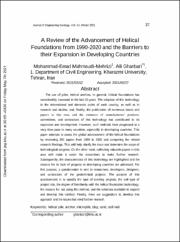| dc.contributor.author | Mahmoudi-Mehrizi, Mohammad-Emad | en_US |
| dc.contributor.author | Ghanbari, Ali | en_US |
| dc.date.accessioned | 1400-02-17T15:35:24Z | fa_IR |
| dc.date.accessioned | 2021-05-07T15:35:24Z | |
| dc.date.available | 1400-02-17T15:35:24Z | fa_IR |
| dc.date.available | 2021-05-07T15:35:24Z | |
| dc.date.issued | 2021-01-01 | en_US |
| dc.date.issued | 1399-10-12 | fa_IR |
| dc.identifier.citation | (1399). نشریه زمین شناسی مهندسی, 14(5), 37-84. | fa_IR |
| dc.identifier.issn | 2228-6837 | |
| dc.identifier.issn | 7386-8222 | |
| dc.identifier.uri | http://jeg.khu.ac.ir/article-1-2990-en.html | |
| dc.identifier.uri | https://iranjournals.nlai.ir/handle/123456789/799399 | |
| dc.description.abstract | The use of piles, helical anchors and, in general, helical foundations has considerably increased in the last 30 years. The adoption of this technology in the international and domestic codes of each country, as well as in research and studies, and, finally, the publication of numerous books and papers in this area, and the existence of manufacturers’ products, committees, and contractors of this technology has contributed to its expansion and development. However, such methods have progressed at a very slow pace in many countries, especially in developing countries. This paper attempts to assess the global advancement of the helical foundations by reviewing 292 papers from 1990 to 2020 and comparing the related research findings. This will help clarify the issue and determine the scope of technological progress. On the other hand, collecting valuable papers in this area will make it easier for researchers to make further research. Subsequently, the characteristics of this technology are highlighted and the reasons for its lack of progress in the developing countries are addressed. For this purpose, a questionnaire is sent to researchers, developers, designers, and contractors of the geotechnical projects. The purpose of this questionnaire is to specify the type of existing projects, the soil type of project site, the degree of familiarity with the helical foundation technology, the reasons for not using this method and the solutions available to expand and develop this method. Finally, there are suggestions to develop this approach and the issues that need further research. | en_US |
| dc.format.extent | 852 | |
| dc.format.mimetype | application/pdf | |
| dc.language | English | |
| dc.language.iso | en_US | |
| dc.publisher | دانشگاه خوارزمی | fa_IR |
| dc.relation.ispartof | نشریه زمین شناسی مهندسی | fa_IR |
| dc.relation.ispartof | Journal of Engineering Geology | en_US |
| dc.subject | helical pile | en_US |
| dc.subject | anchor | en_US |
| dc.subject | micropile | en_US |
| dc.subject | clay | en_US |
| dc.subject | sand | en_US |
| dc.subject | soil nail | en_US |
| dc.subject | Geotecnic | en_US |
| dc.title | A review of the advancement of helical foundations from 1990- 2020 and the barriers to their expansion in developing countries | en_US |
| dc.type | Text | en_US |
| dc.type | Research Paper | en_US |
| dc.contributor.department | Department of Civil Engineering | en_US |
| dc.contributor.department | Department of Civil Engineering | en_US |
| dc.citation.volume | 14 | |
| dc.citation.issue | 5 | |
| dc.citation.spage | 37 | |
| dc.citation.epage | 84 | |





